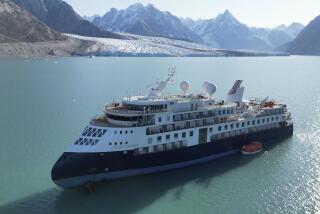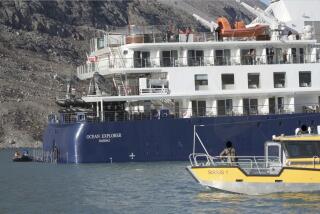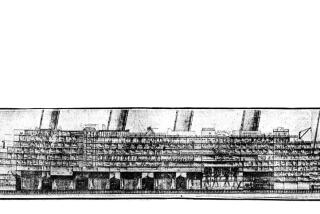800 Lost at Sea in Ferry Disaster : Baltic Sea: There are 126 survivors from the vessel that sailed from Estonia for Sweden. A crew member is quoted as saying a loading ramp was improperly closed.
STOCKHOLM — Two boats arrived here late Wednesday night carrying 32 survivors of a sunken Estonian passenger ferry who had been scooped from the swollen Baltic Sea. Their arrival at the chilly harbor-front terminal brought whimpers of relief from desperate relatives but also brought to a bittersweet close the most tragic day on the Baltic since World War II.
Authorities say the Swedish survivors are probably the last passengers from the doomed ferry who will be found alive, bringing the tally of those rescued to 126. Estimates vary of the number of people aboard the ferry when it sank in a severe storm early Wednesday en route to the Swedish capital, but authorities fear that more than 800 people are dead.
Rescue boats and helicopters braved high winds and pitching seas all day, checking and double-checking life rafts for survivors and making several miraculous snatches from the 50-degree water. But officials in Turku, Finland, where the rescue was organized, called off the search at nightfall because of safety concerns.
“There is very little hope of finding anyone alive,” said Finnish Coast Guard Capt. Raimo Tiilikainen, who said the search for bodies will resume at dawn today. By sundown Wednesday, 42 had been found.
For hundreds of family members holed up in a hotel not far from the Stockholm ferry terminal, where the boat Estonia was to have docked Wednesday morning after an overnight trip from the Estonian capital of Tallinn, the suspended rescue effort was just the latest in a day of heartbreaking reports.
Officials said the majority of those on board the Estonia were Swedes, including about 60 civilian employees of the Stockholm Police Department, several dozen members of a Swedish senior citizens club and several judges returning home after visiting Estonian counterparts. Authorities said the ship carried passengers from Sweden, Estonia, Latvia, Lithuania, Canada, Russia, Nigeria, Finland, Norway, Britain and Belarus.
“It is a very big shock for everyone,” said Stockholm Police Chief Richard Sevelius. “There is nothing to compare it with.”
Social workers said a young pregnant woman went into premature labor when she learned her fiance was not among those rescued, and other despondent relatives fainted or broke into hysterics as the hours of uncertainty dragged on. Dozens of counselors, clergymen and other volunteers tended distraught family members, whose counterparts gathered in Tallinn and in Turku, where most survivors in need of immediate medical care were taken.
“I can’t describe how horrible it was to watch as an 11-year-old boy realized he had lost his father,” said a glassy-eyed Carl Tosterud, a 20-year-old Red Cross volunteer at the Stockholm ferry terminal. “There are enormous tragedies wherever you turn.”
One woman standing near the docks at the Tallinn waterfront clutched a teddy bear and wept. “My husband and son were on their way to Sweden,” she said. “My son left his teddy bear behind.”
Wednesday was declared a national day of mourning in Sweden, Estonia and Finland, and the prime ministers of the three countries met in Finland to coordinate the rescue effort and launch an investigation.
“It was a terrible night for Estonia,” declared Estonian Prime Minister Mart Laar, saying it reminded him of another Baltic tragedy in 1944 when many Estonians drowned trying to flee the occupying Soviet army.
“It is a human tragedy beyond belief,” said Swedish Prime Minister Carl Bildt, “the worst disaster in my country in at least a century.”
Officials from the three countries would not speculate about the cause of the accident, saying the ferry first needs to be recovered from the sea floor and analyzed.
But several Scandinavian and Estonian news reports quoted a surviving crew member as saying that one of the ferry’s loading ramps was not closed properly, allowing water to rush in.
“There was something wrong,” crew member Henrik Sillaste said, according to the reports. “The outer ramp was closed but the inner door was not properly attached. Water was forcing its way through. There was so much water on the lower deck that it almost reached my knees.”
Carl-Gustaf Akerhielm, spokesman for the ferryboat’s co-owner, Estline, would not comment, saying “there are so many rumors around” that he did not want to guess which ones might be true. He also would not comment on reports that two Swedish ferry inspectors, apparently on a training mission, had noted defects in the loading ramp doors prior to the ship’s departure Tuesday night.
“I don’t have a clear idea, and I am not going to speculate,” Akerhielm said. “I cannot assume a major fault with the vessel. For me it is a mystery, and I am very astonished.”
Authorities said bad weather alone would not have been enough to sink the 515-foot-long boat, which in addition to its passengers carried 77 vehicles. Kari Lehtola, an official with the Finnish Ministry of Justice and a member of the investigation team, said it is not unusual for ferries to operate on the Baltic in bad weather. The Estonia, which sank about six hours into its sea crossing, was blasted by 20-foot waves and 56-m.p.h winds.
“They sail this route every day of the year,” Lehtola said.
The Estonia, built in 1980 in West Germany and owned by the Swedish company Nordstrom & Thulin and the state Estonian Shipping Co., issued a distress signal at 1:24 a.m. that was picked up by the Coast Guard in Turku.
Estonian Transport Minister Andi Meister said the crew actually sent two Mayday signals before going down, but the vessel’s automated distress system, which would have signaled its exact coordinates, did not work.
By the time the first of 16 rescue boats arrived at the scene near the Finnish island of Uto two hours later, the ferry was nowhere in sight. Some passengers said it took only a matter of minutes for it to sink.
“Mayday! Here is Estonia! Outside Uto lighthouse. We have listed 20 to 30 degrees,” the Finnish Coast Guard quoted the distress signal. Communication then broke off.
Passenger Lars Lamke, a Stockholm doctor who survived the disaster, said many people were sleeping when the boat began to list uncontrollably.
Clad in green hospital-issued pajamas in Turku, a hospital identity tag hanging around his neck, 63-year-old Lamke was able to describe in detail the way it felt to be aboard the fast-sinking ship--impressions that may prove useful in the coming days and weeks as investigators try to piece together what happened.
“I realized something was wrong when all of my luggage started rushing down” toward the door of his sleeping compartment, Lamke said. By that time, he said, the ship was tilting so severely that he found it hard to push the baggage aside and open the door.
Lamke said it may have been the location of his sleeping quarters that saved him. He was on the sixth floor of the ship, and the life rafts were just upstairs on the seventh. He made his way toward the stairs with his companion, who is missing and presumed dead, climbed to the top, opened the door and felt a fierce wind blowing.
Rescuers found Lamke’s raft just as the sky was starting to get light. A helicopter took him and his lifeboat mates to a small military hospital on the Finnish coastal island of Uto, and then moved them to Turku. Many of those brought there needed intensive measures to warm them up, but Lamke needed only an X-ray and some stitches for a cut on his left hand.
Lamke’s doctor says that the emotional wounds that he and the others have suffered will take far longer to heal. “They have all sustained a kind of mental shock,” said Juha Niinkoski, head of the cardiology unit at Turku University Hospital.
“They will have difficulties in the coming days as they realize what really happened.”
Murphy reported from Stockholm and Walsh from Turku, Finland. Times special correspondents Lisa Trei and Eva Tarm in Tallinn, Estonia, also contributed to this report.
Sinking of the Estonia
At least 800 people are feared dead after a ferry from Tallinn, Estonia, sank in stormy waters off the coast of Finland. The ill-fated vessel was headed for Stockholm.
How It Happened
All times local, hour approximate
1) 7 p.m. Tuesday. Ferry leaves Tallinn.
2) 8:30 p.m. Ferry runs into heavy weather and 20-foot waves.
3) Midnight. An engineer notices water coming in from the bow door. Crew puts out first Mayday.
12:15 a.m. Wednesday. Pumps are overwhelmed. The ferry lists toward the bow from the weight of the water.
1:55 a.m. Two of the ship’s four engines shut off.
2 a.m. The ship sinks
The Vessel
* Owner: Nordstrom & Thulin of Sweden and the Estonian government.
* Operator: Estline, Estonia
* Length: 515 feet, 15,566 tons
* Crew: 188
* Capacity: 2,000 passengers
* Vehicle Capacity: 460
A Frigid Death
For those able to jump off the sinking vessel, the cold waters of the Baltic Sea posed a serious health problem--hypothermia. In severe hypothermia, a person’s breathing slows, muscles stiffen, he or she loses consciousness and may die.
Sources: Associated Press, American Medical Assn. Encyclopedia of Medicine
More to Read
Sign up for Essential California
The most important California stories and recommendations in your inbox every morning.
You may occasionally receive promotional content from the Los Angeles Times.










